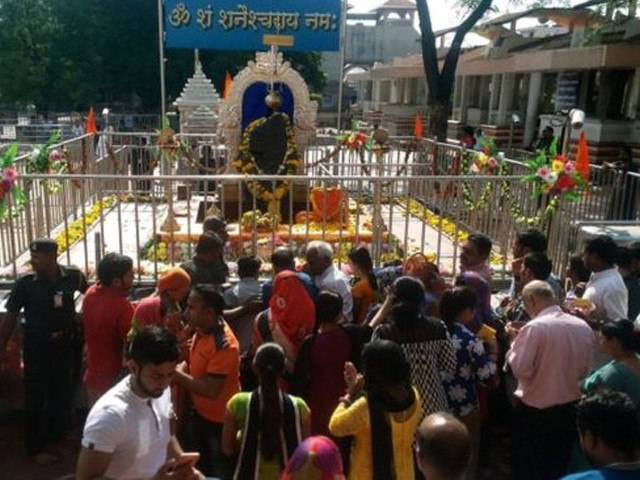On January 26, while most Indians celebrated the participation of an all-women’s contingent during India’s Republic Day Parade, 400 strong women activists did what has never been done before: they forcefully tried to enter the Shani Shingnapur temple in Maharashtra to break an age old custom that prevents women from entering the sanctum sanctorum of the temple. The attempt was a symbolic act to assert women’s rights and fight patriarchy.
Indian women have for long struggled to attain gender equality, and as education increases, more and more women can be seen employed in the corporate world and the government.
Banning women from temples is against the very core of female empowerment, considering their rights have been denied in India since the Vedic times, even though Durga, Saraswati and Lakshmi – who symbolise power, education and wealth, respectively – are worshipped by all Hindus.
Priests and religious Hindu scholars defend the custom of barring women from entering the sacred Shani temple by claiming that the ‘vibrations’ that emerge from Lord Shani have harmful effects on women. They reason that the,
“Issue of women not being allowed to worship Lord Shani from close proximity should not be seen as gender inequality.”
A temple dedicated to Saturn solely affects women? I have never heard a more ludicrous argument!
Activists rejecting the above argument have approached the Bombay High Court and have sought the implementation of the Maharashtra Hindu Places of Public Worship (Entry Authorisation) Act, 1956, which reads,
“.. no Hindu of whatsoever section or class shall in any manner be prevented, obstructed or discouraged from entering such place of public worship or from worshiping or offering prayers there at, or performing any religious service therein…”
As per the Act, prohibiting any person from entering a temple is punishable by six months in jail.
In a major blow to religious groups, the Bombay High Court has asked the Maharashtra government to ensure that, as per the law, women are not denied entry into any temple. However, instead of bringing in reforms to amend such customs, Indian religious leader Shankaracharya Swaroopanand made matters worse by claiming that allowing women into a temple devoted to Lord Shani (Saturn) would “increase incidents of rape”.
Such insensitive remarks will only help the cause of all those who are against women’s empowerment and don’t want them to be treated as equals.
A similar controversy revolves around the Lord Ayyappa Temple at Sabarimala in Kerala; it bars women of menstrual age (between 10 and 50). This is a violation of women’s constitutional rights, as can be seen under Article 14 of the Constitution, which guarantees equality to all. It is said that Lord Sabarimala was a brahmachari (bachelor) who took a vow of celibacy, which is why women are not allowed into the premises, especially those that have attained puberty.
In Hinduism, it is also frowned upon to do pooja (worship) at religious events or temples if a woman is menstruating. To add salt to the wound, the chief of Sabarimala Board had created a huge uproar with his following statement,
“The day there will be a machine to detect if it's the ‘right time’ for women to enter temples, that day they will be allowed in Sabarimala”
India has long witnessed the discrimination against women as well as people belonging to lower castes by disallowing them from entering the temple. It is for this reason many people who belong to lower strata of society have embraced religions like Buddhism, Christianity and Islam, more as a protest against the discriminatory practices of Hinduism.
Much like the Hindu women in Ahmednagar, Muslim women in Mumbai are demanding that they be allowed to pray in the sanctum of Haji Ali, a famous shrine in Mumbai. It is surprising that Islam gives women equality but does not grant them permission to enter graveyards and Dargahs. It is only a question of time before they get access to the shrine.
Not only is it discriminatory, it is anachronistic to ban women entry into temples as all beings are equal in the eyes of God. Mahatma Gandhi fought on behalf of Dalits entering temples. Alas, people who are involved with religious teachings have not learnt any lesson from him. We need to correct this evil socio-religious malady and take steps for women and for people belonging to marginalised sections of society to have free ingress to temples and mosques.
The Supreme Court, where a petition has been filed by the Indian Young Lawyers Association, has questioned the prohibition on allowing women to enter the Lord Ayyappa Temple at Sabarimala in Kerala, stating that this ban has no constitutional basis. It is hoped that the apex court will soon deliver a judgment to settle the rights of women to enter the sanctum sanctorum of temples once and for all.
In the meantime, there is a crying need to revisit the anachronistic customs and rituals of all religions, and bring them in line with modern liberal values. The sooner we remove the dichotomy between liberal values, regressive traditions and customs, the sooner we will be able to succeed in preventing possible social upheaval in society.



COMMENTS
Comments are moderated and generally will be posted if they are on-topic and not abusive.
For more information, please see our Comments FAQ